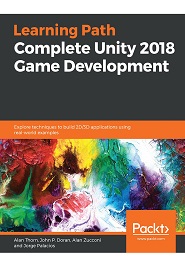
English | 2019 | ISBN: 978-1789952865 | 738 Pages | PDF, EPUB | 752 MB
Leverage the power of the Unity 2018 game engine to create games with brilliant gameplay and high replayability.
Through this Learning Path, you’ll learn how to leverage the features of Unity and create amazing games, ranging from action shooters and mind-bending puzzle games to adventure and Virtual Reality(VR) games. If you have no prior experience of using Unity, you can still benefit from this Learning Path, which easily explains the complete working of the Unity toolset.
You’ll start by learning how to create compelling shaders using Unity and understanding everything you need to know about vectors. This includes useful inputs on how lighting is constructed with vectors and how textures are used to create complex effects without the need for advanced math. In the succeeding chapters, you’ll also be able to use popular AI techniques, such as A* and A*mbush to develop intelligent pathfinding agents for your games. The book will also guide you through different algorithms for creating decision-making agents that go beyond simple behaviors and movement.
By the end of this Learning Path, you will have developed all the basic skills to create highly engaging and replayable games.
This Learning Path includes content from the following Packt products:
- Unity 2018 By Example – Second Edition by Alan Thorn
- Unity 2018 Shaders and Effects Cookbook – Third Edition by John P. Doran, Alan Zucconi
- Unity 2018 Artificial Intelligence Cookbook – Second Edition by Jorge Palacios
What you will learn
- Understand concepts such as game objects, components, and scenes
- Create functional games with C# scripting
- Write shaders from scratch in ShaderLab and HLSL/Cg
- Develop intelligent pathfinding agents with A and Ambush
- Work with terrains and world-creation tools
- Simulate senses for agents to make decisions based on the environment
- Implement waypoints by creating a manual selector
- Enhance games with volumetric explosions, special effects, and visuals
Resolve the captcha to access the links!